Integrating 'art' into research with children
中学生艺术素养计划目标
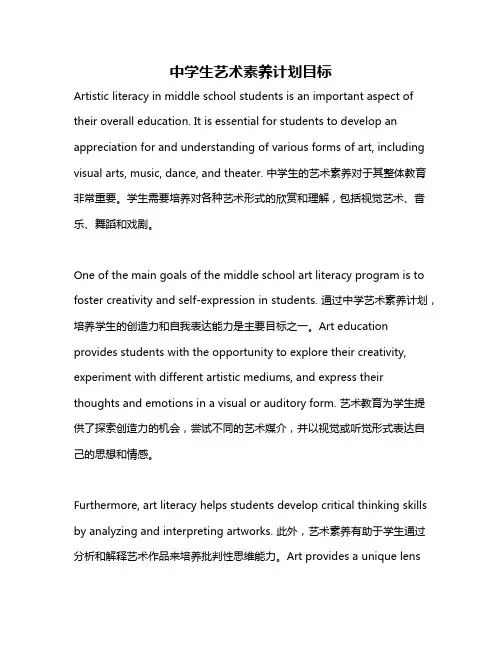
中学生艺术素养计划目标Artistic literacy in middle school students is an important aspect of their overall education. It is essential for students to develop an appreciation for and understanding of various forms of art, including visual arts, music, dance, and theater. 中学生的艺术素养对于其整体教育非常重要。
学生需要培养对各种艺术形式的欣赏和理解,包括视觉艺术、音乐、舞蹈和戏剧。
One of the main goals of the middle school art literacy program is to foster creativity and self-expression in students. 通过中学艺术素养计划,培养学生的创造力和自我表达能力是主要目标之一。
Art education provides students with the opportunity to explore their creativity, experiment with different artistic mediums, and express their thoughts and emotions in a visual or auditory form. 艺术教育为学生提供了探索创造力的机会,尝试不同的艺术媒介,并以视觉或听觉形式表达自己的思想和情感。
Furthermore, art literacy helps students develop critical thinking skills by analyzing and interpreting artworks. 此外,艺术素养有助于学生通过分析和解释艺术作品来培养批判性思维能力。
我认为应增加美术的作文英语
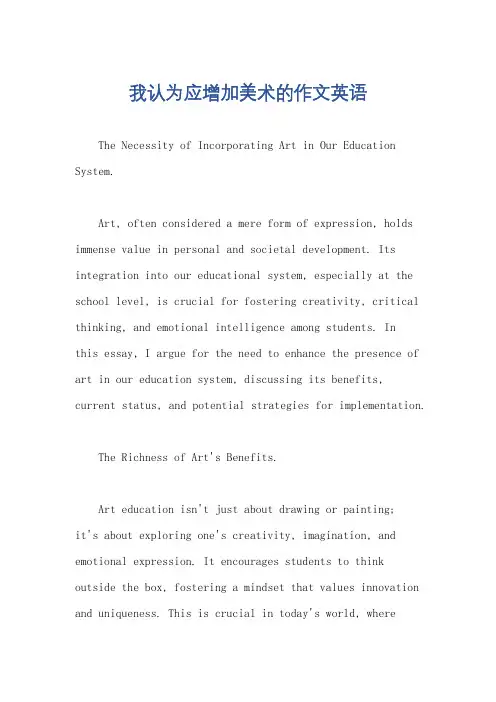
我认为应增加美术的作文英语The Necessity of Incorporating Art in Our Education System.Art, often considered a mere form of expression, holds immense value in personal and societal development. Its integration into our educational system, especially at the school level, is crucial for fostering creativity, critical thinking, and emotional intelligence among students. Inthis essay, I argue for the need to enhance the presence of art in our education system, discussing its benefits,current status, and potential strategies for implementation.The Richness of Art's Benefits.Art education isn't just about drawing or painting;it's about exploring one's creativity, imagination, and emotional expression. It encourages students to think outside the box, fostering a mindset that values innovation and uniqueness. This is crucial in today's world, whereproblem-solving and adaptability are key skills.Moreover, art acts as a powerful medium for emotional expression. It helps students process their feelings, understand their emotions, and communicate them effectively. This emotional intelligence is essential for building healthy relationships, managing stress, and overall well-being.The Current Status of Art Education.Unfortunately, the current state of art education in many school systems is lacking. It's often seen as a non-core subject, given less attention and resources than other subjects like science, math, or languages. This approach is shortsighted, as it underestimates the significant role art plays in personal and cognitive development.Strategies for Implementation.To address this, several strategies can be implemented. Firstly, schools should provide more funding and resourcesfor art education, ensuring that students have access to quality art supplies and teachers. Secondly, art should be integrated into the curriculum, not just as a standalone subject but also as a tool to enhance other subjects. For example, art can be used to teach history by analyzing historical artworks or to teach science by illustrating complex concepts visually.Additionally, schools can collaborate with local art communities and organizations to provide students with more opportunities to engage with art. This could include visits to art museums, workshops with professional artists, or even partnerships with local artists to create art installations or performances within the school.The Role of Teachers and Educators.Teachers and educators play a crucial role in promoting art education. They need to be trained and equipped with the necessary skills to effectively teach art and incorporate it into their classrooms. They should also be encouraged to be creative and innovative in their teachingmethods, using art as a tool to engage students and make learning more fun and meaningful.Conclusion.In conclusion, the integration of art into our education system is essential for fostering creativity, critical thinking, and emotional intelligence among students. It's a powerful tool that can enhance learning in other subjects, promote personal development, and prepare students for the challenges of the future. By providing more funding and resources, integrating art into the curriculum, and collaborating with local art communities, we can ensure that every student has access to a comprehensive and well-rounded education that includes the richness and value of art.。
高中将美术变为必修课的英语作文
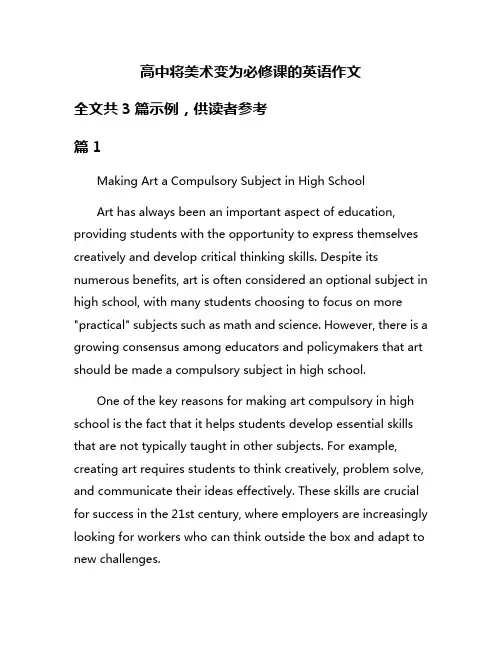
高中将美术变为必修课的英语作文全文共3篇示例,供读者参考篇1Making Art a Compulsory Subject in High SchoolArt has always been an important aspect of education, providing students with the opportunity to express themselves creatively and develop critical thinking skills. Despite its numerous benefits, art is often considered an optional subject in high school, with many students choosing to focus on more "practical" subjects such as math and science. However, there is a growing consensus among educators and policymakers that art should be made a compulsory subject in high school.One of the key reasons for making art compulsory in high school is the fact that it helps students develop essential skills that are not typically taught in other subjects. For example, creating art requires students to think creatively, problem solve, and communicate their ideas effectively. These skills are crucial for success in the 21st century, where employers are increasingly looking for workers who can think outside the box and adapt to new challenges.Furthermore, art plays a critical role in fostering emotional intelligence and empathy in students. Through making art, students are able to explore their feelings and emotions in a safe and supportive environment. This can help them develop a deeper understanding of themselves and others, leading to better relationships and a more fulfilling life.Another important reason for making art compulsory in high school is its ability to engage students who may struggle in traditional academic subjects. For many students, art is a way to learn and express themselves that is more accessible and enjoyable than traditional classroom activities. By giving all students the opportunity to participate in art classes, we can create a more inclusive and supportive learning environment for everyone.Additionally, art can help students develop a greater appreciation for the beauty and diversity of the world around them. By studying art history and creating their own artwork, students can learn about different cultures, traditions, and perspectives. This can help them become more open-minded and empathetic individuals, leading to a more tolerant and inclusive society.In conclusion, making art a compulsory subject in high school is essential for helping students develop essential skills, fostering emotional intelligence, engaging all students in the learning process, and promoting a greater appreciation for diversity. By prioritizing art education, we can help students become more creative, empathetic, and well-rounded individuals who are prepared to succeed in the 21st century.篇2Making Art Compulsory in High SchoolIn recent years, there has been a growing interest in the idea of making art a compulsory subject in high schools. Advocates for this change argue that art education can provide students with numerous benefits, including improved creativity, critical thinking skills, and mental well-being. In this essay, we will explore the reasons why art should be included as a mandatory subject in high school curricula.First and foremost, art education plays a crucial role in fostering creativity and innovation. Through engaging with various art forms such as painting, sculpture, and music, students are encouraged to think outside the box and explore unconventional ideas. This can help them develop the ability tosolve problems creatively and come up with innovative solutions in other areas of their lives.Moreover, studying art can enhance students' critical thinking skills. By analyzing and interpreting artworks, students are challenged to think critically about the messages and themes conveyed by the artist. This can help them develop their ability to analyze complex ideas, make informed judgments, and communicate their thoughts effectively.In addition, art education can have a positive impact on students' mental well-being. Engaging with art can provide a therapeutic outlet for students to express their emotions, relieve stress, and develop a sense of self-awareness. Research has shown that participating in artistic activities can reduce anxiety, depression, and improve overall mental health.Furthermore, including art as a mandatory subject in high school can help promote cultural diversity and appreciation. By studying art from different cultures and time periods, students can gain a deeper understanding of the world around them and develop empathy for others. This can help foster a sense of global citizenship and promote tolerance and respect for diverse perspectives.Despite the numerous benefits of art education, some critics argue that making art compulsory in high schools may detract from other core subjects such as math and science. However, research has shown that integrating art into the curriculum can actually enhance students' performance in these subjects. Studies have found that students who participate in art programs demonstrate improved academic achievement, higher test scores, and increased motivation to learn.In conclusion, there are compelling reasons to make art a mandatory subject in high school curricula. From fostering creativity and critical thinking skills to promoting mentalwell-being and cultural appreciation, art education offers a wide range of benefits for students. By including art as a compulsory subject, high schools can provide students with the tools they need to succeed in an increasingly complex and interconnected world.篇3Should Fine Arts be Made a Compulsory Subject in High School?IntroductionFine arts, including disciplines such as painting, sculpture, and photography, have long been an important part of the curriculum in many high schools. However, in some educational systems, it is not a compulsory subject. This raises the question: should fine arts be made a compulsory subject in high school? In this essay, I will explore the arguments for and against making fine arts compulsory in high school.Arguments in favor of Making Fine Arts a Compulsory Subject1. Creative Development: Fine arts help students to develop their creativity and imagination. By engaging in activities such as drawing, painting, and sculpting, students can explore new ways of thinking and expressing themselves.2. Emotional Expression: Fine arts provide an outlet for students to express their emotions and feelings. Through creating art, students can communicate their thoughts and experiences in a non-verbal way.3. Cultural Appreciation: Studying fine arts can help students to appreciate and understand different cultures. By learning about the art and traditions of other societies, students can develop a broader perspective on the world.4. Critical Thinking: Fine arts require students to think critically and problem-solve. By analyzing and interpreting works of art, students can develop their analytical skills and learn to think creatively.5. Stress Relief: Engaging in fine arts can provide students with a form of stress relief. Creating art can be a therapeutic activity that allows students to relax and unwind.Arguments Against Making Fine Arts a Compulsory Subject1. Limited Resources: Some schools may not have the resources to offer fine arts as a compulsory subject. Art supplies can be expensive, and hiring qualified art teachers may be difficult for some schools.2. Student Interest: Not all students may have an interest in fine arts. Forcing students to study a subject that they are not passionate about may lead to disengagement and lack of motivation.3. Academic Pressure: High school students already have a heavy academic workload. Adding fine arts as a compulsory subject may increase the stress and pressure on students.4. Career Prospects: Some students may not see the value of studying fine arts in terms of their future career prospects. Theymay prioritize subjects that they believe will be more beneficial in the job market.ConclusionIn conclusion, the question of whether fine arts should be made a compulsory subject in high school is a complex and multifaceted issue. While there are clear benefits to studying fine arts, there are also challenges to implementing it as a compulsory subject. Ultimately, the decision to make fine arts compulsory should be based on a careful consideration of the needs and interests of students, as well as the resources available to schools.。
公共艺术设计英语
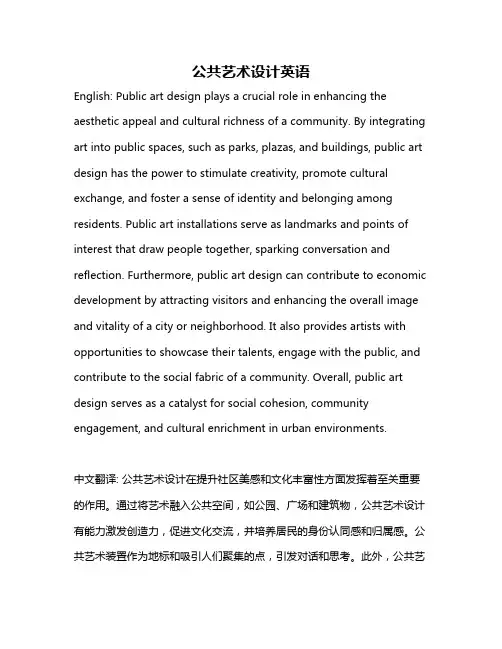
公共艺术设计英语English: Public art design plays a crucial role in enhancing the aesthetic appeal and cultural richness of a community. By integrating art into public spaces, such as parks, plazas, and buildings, public art design has the power to stimulate creativity, promote cultural exchange, and foster a sense of identity and belonging among residents. Public art installations serve as landmarks and points of interest that draw people together, sparking conversation and reflection. Furthermore, public art design can contribute to economic development by attracting visitors and enhancing the overall image and vitality of a city or neighborhood. It also provides artists with opportunities to showcase their talents, engage with the public, and contribute to the social fabric of a community. Overall, public art design serves as a catalyst for social cohesion, community engagement, and cultural enrichment in urban environments.中文翻译: 公共艺术设计在提升社区美感和文化丰富性方面发挥着至关重要的作用。
你觉得把高雅艺术引入校园样英语作文
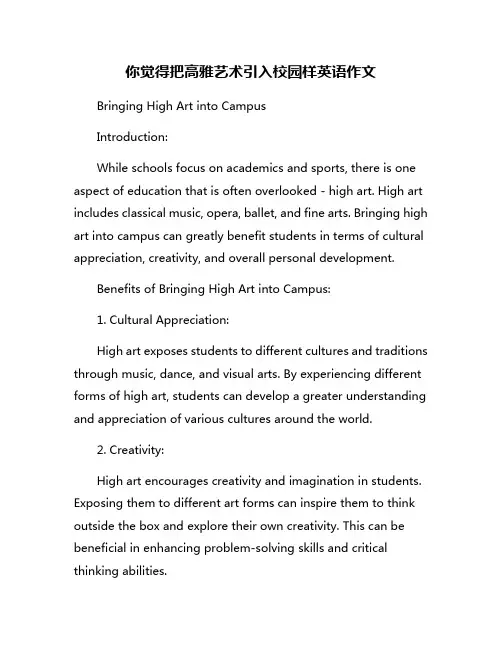
你觉得把高雅艺术引入校园样英语作文Bringing High Art into CampusIntroduction:While schools focus on academics and sports, there is one aspect of education that is often overlooked - high art. High art includes classical music, opera, ballet, and fine arts. Bringing high art into campus can greatly benefit students in terms of cultural appreciation, creativity, and overall personal development.Benefits of Bringing High Art into Campus:1. Cultural Appreciation:High art exposes students to different cultures and traditions through music, dance, and visual arts. By experiencing different forms of high art, students can develop a greater understanding and appreciation of various cultures around the world.2. Creativity:High art encourages creativity and imagination in students. Exposing them to different art forms can inspire them to think outside the box and explore their own creativity. This can be beneficial in enhancing problem-solving skills and critical thinking abilities.3. Personal Development:High art can also contribute to students' personal development. It can help them develop a sense of discipline, patience, and dedication as they learn and practice various art forms. It can also instill a sense of appreciation for beauty and excellence in students.Ways to Integrate High Art into Campus:1. Introduce High Art Classes:Schools can introduce high art classes as part of the curriculum. This can include music appreciation, art history, dance classes, and theater workshops. These classes can provide students with a foundation in high art and expose them to different art forms.2. Organize Cultural Events:Schools can organize cultural events such as music concerts, art exhibitions, dance performances, and theater productions. These events can showcase high art to students and the wider community, and provide them with an opportunity to experience and appreciate different art forms.3. Invite Guest Artists:Schools can invite guest artists such as musicians, dancers, and visual artists to campus to conduct workshops and masterclasses. This can give students the opportunity to learn from professionals in the field and gain insights into the world of high art.Conclusion:Bringing high art into campus can greatly benefit students in terms of cultural appreciation, creativity, and personal development. By integrating high art into the curriculum and organizing cultural events, schools can expose students to different art forms and inspire them to explore their own creativity. High art can play a valuable role in shapingwell-rounded and culturally-aware individuals.。
传承书法文化英语作文
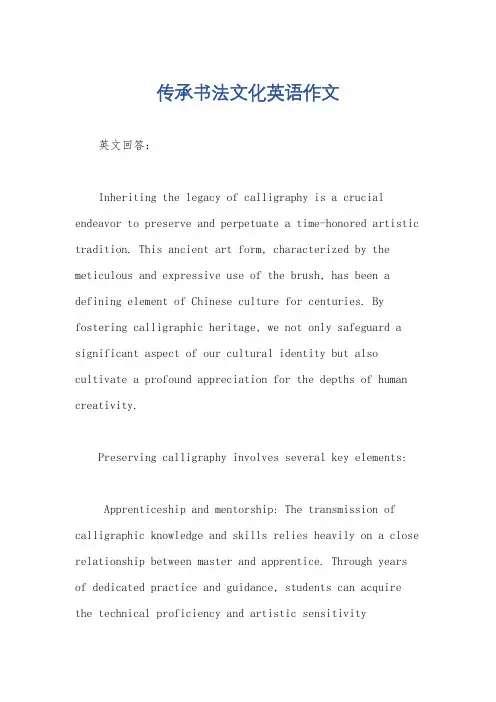
传承书法文化英语作文英文回答:Inheriting the legacy of calligraphy is a crucial endeavor to preserve and perpetuate a time-honored artistic tradition. This ancient art form, characterized by the meticulous and expressive use of the brush, has been a defining element of Chinese culture for centuries. By fostering calligraphic heritage, we not only safeguard a significant aspect of our cultural identity but also cultivate a profound appreciation for the depths of human creativity.Preserving calligraphy involves several key elements:Apprenticeship and mentorship: The transmission of calligraphic knowledge and skills relies heavily on a close relationship between master and apprentice. Through years of dedicated practice and guidance, students can acquire the technical proficiency and artistic sensitivitynecessary to master this intricate art.Education and outreach: Integrating calligraphy into educational curricula and promoting it through exhibitions, workshops, and online resources can foster a broader understanding and appreciation of its significance. By exposing future generations to the beauty and complexity of calligraphy, we inspire them to continue its lineage.Preservation and documentation: Safeguardinghistorical calligraphic works and manuscripts is vital to preserving the legacy of this art form. Digitalization, archival storage, and research projects contribute to ensuring the accessibility and longevity of these precious artifacts.The benefits of inheriting calligraphy extend beyond mere preservation. By engaging with this art, we gain insights into our cultural history, cultivate a refined aesthetic sensibility, and develop a deep appreciation for artistic expression. Calligraphy also promotes patience, concentration, and a connection to the present moment.In essence, inheriting书法文化(shūfǎ wénhuà) is an act of reverence for our artistic heritage and a commitment to its future. By fostering this tradition through apprenticeship, education, preservation, and appreciation, we ensure its enduring legacy as a source of inspiration and cultural connection.中文回答:传承书法文化。
让艺术融入生活英语作文
让艺术融入生活英语作文Title: Integrating Art into Daily Life。
Art is not merely confined to the walls of museums or the pages of history books; it is a dynamic force that has the potential to enrich every aspect of our lives. From the vibrant strokes of a painting to the intricate melodies of music, art has the power to evoke emotions, provoke thoughts, and inspire creativity. Integrating art into our daily lives not only enhances our aesthetic experiences but also fosters a deeper appreciation for the beauty and diversity of the world around us.One of the simplest ways to incorporate art into daily life is through visual appreciation. Surrounding ourselves with artwork, whether it be paintings, sculptures, or photographs, can create a more visually stimulating environment. This can be achieved by hanging artwork on walls, displaying sculptures on shelves, or even using everyday objects like mugs or cushions adorned withartistic designs. By integrating art into our living spaces, we transform ordinary surroundings into dynamic expressions of creativity and beauty.Moreover, engaging with art can also be a deeply personal and introspective experience. Taking the time to visit art galleries, attend performances, or explorecreative workshops allows us to connect with our inner selves and explore new perspectives. Whether we find solace in the quiet contemplation of a sculpture or joy in the rhythm of a dance performance, art has the power to evoke a wide range of emotions and enrich our inner lives.In addition to enriching our personal experiences, integrating art into daily life can also strengthen social bonds and foster community engagement. Participating inart-related activities such as group painting sessions, community theater productions, or collaborative music performances brings people together in a shared celebration of creativity and expression. Through these collective experiences, we not only forge connections with others but also contribute to the cultural vitality of our communities.Furthermore, embracing art in our daily lives can inspire us to approach challenges with creativity and innovation. The process of creating art encourages us to think outside the box, experiment with new ideas, and embrace imperfection as part of the creative journey. Whether we are painting a canvas, composing a piece of music, or writing a poem, art allows us to express ourselves freely and explore the limitless possibilities of human imagination.In conclusion, integrating art into daily life is not merely about decorating our surroundings or filling our leisure time; it is about embracing creativity, fostering personal growth, and building vibrant communities. By surrounding ourselves with art, engaging with creative experiences, and celebrating our unique expressions of creativity, we invite the transformative power of art into every aspect of our lives. As we embark on this journey of artistic exploration, let us open our hearts and minds to the beauty and inspiration that surrounds us, and let art become an integral part of our daily lives.。
绘画是否应该成为必修课英语作文
绘画是否应该成为必修课英语作文As the debate on whether painting should be a mandatory subject continues, opinions are divided. While some argue that painting is an essential skill that fosters creativity and self-expression, others contend that it may not be practical or necessary for all students. In this essay, we will explore both perspectives and conclude with our thoughts on the matter.Those in favor of making painting a compulsory subject assert that it plays a crucial role in developingcreativity among students. Painting encourages individuals to think outside the box and express their unique ideas visually. It allows for personal interpretation of emotions and experiences, which can have a positive impact on mental well-being. Moreover, painting teaches patience, focus, and attention to detail as artists diligently work onperfecting their creations.Furthermore, advocates argue that painting can contribute to cross-disciplinary learning. By integrating art into thecurriculum, students gain opportunities to develop critical thinking skills and explore diverse perspectives. This interdisciplinary approach enhances comprehension and problem-solving abilities since learners engage inanalyzing compositions, colors, and spatial relationships. Such skills can be transferred to various subjects likemath or science where visual representation plays an important role.However, opponents question the practicality of mandating painting as a compulsory subject for all students. They argue that not every student possesses an inherent artistic talent or interest in painting. Forcing them to participate in such activities may lead to frustration and demotivation. Additionally, they believe that valuable instructional time might be better utilized by focusing on core academic subjects that are more directly applicable in today's competitive job market.Another concern raised by critics is related to resource allocation. Incorporating painting into the curriculumwould require additional funding for art supplies andspecialized instructors. Some schools already struggle with limited budgets; therefore, diverting resources from other areas could negatively affect overall educational quality.Despite these concerns, it is important to recognize the potential benefits of offering painting as a mandatory subject while addressing practicality issues raised by opponents. A compromise could be reached by introducing painting as an elective subject or integrating art into existing subjects in a cross-disciplinary manner.In conclusion, the debate over whether painting should be made compulsory in schools continues to evoke strong and varied opinions. While painting undeniably promotes creativity, self-expression, and interdisciplinary learning, questions about practicality and resource allocation cannot be dismissed. Striking a balance between fostering artistic skills and addressing the diverse needs of students is crucial. Ultimately, providing opportunities for artistic growth while accommodating individual interests and talents should be at the forefront of curriculum design decisions.。
艺术好处英文作文
艺术好处英文作文Title: The Benefits of Art: A Comprehensive Exploration。
Art, in its myriad forms, has long been celebrated for its profound impact on individuals and societies alike. From visual arts to music, literature to performance, the realm of artistic expression holds a unique ability toenrich lives in countless ways. In this essay, we delveinto the multifaceted benefits of art, exploring itscapacity to inspire, educate, heal, and unify.To begin with, art serves as a powerful source of inspiration. Through the creative endeavors of artists, individuals are exposed to new perspectives, ideas, and emotions that stimulate their imagination and expand their horizons. Whether it's a captivating painting, a soul-stirring melody, or a thought-provoking novel, art has the ability to ignite the spark of inspiration within us,driving us to explore our own creativity and pursue our passions.Moreover, art plays a vital role in education. In addition to fostering creativity and critical thinking skills, exposure to art enhances cognitive development and academic performance. Studies have shown that students engaged in arts education demonstrate improved problem-solving abilities, better communication skills, and increased empathy. By integrating art into the curriculum, educators can create dynamic learning environments that cater to diverse learning styles and nurture well-rounded individuals.Furthermore, art has significant therapeutic benefits. For centuries, art therapy has been utilized as a means of promoting emotional well-being and healing. Through the process of creative expression, individuals can explore and process their thoughts, feelings, and experiences in a safe and supportive environment. Whether it's painting, sculpting, or writing, engaging in artistic activities can alleviate stress, reduce anxiety, and enhance self-awareness. Art therapy is particularly effective in helping individuals cope with trauma, grief, and mental healthdisorders, offering a holistic approach to healing that integrates the mind, body, and spirit.In addition to its individual benefits, art also has the power to unite communities and bridge cultural divides. Through shared artistic experiences, people from diverse backgrounds can come together to celebrate their common humanity and appreciate the richness of cultural diversity. Whether it's a community mural project, a multicultural festival, or a collaborative performance, art has theability to foster social cohesion, promote understanding, and create a sense of belonging.Moreover, art serves as a catalyst for social change. Throughout history, artists have used their creative platforms to challenge injustice, provoke thought, and inspire action. From the political satire of cartoonists to the protest songs of musicians, art has been instrumentalin sparking social movements and advancing the cause of equality and justice. By shining a spotlight on pressing issues and giving voice to the marginalized, art has the power to effect meaningful change and shape the course ofhistory.In conclusion, the benefits of art are vast and far-reaching. From inspiring creativity and enhancing education to promoting healing and fostering social cohesion, art enriches our lives in countless ways. As we continue to recognize and celebrate the transformative power of art,let us strive to cultivate a society that values and prioritizes the arts as essential to the human experience.。
高雅艺术进校园英语作文
高雅艺术进校园英语作文Paragraph 1:Art is a beautiful expression of human creativity and imagination. It has the power to evoke emotions, provoke thoughts, and inspire individuals. When art enters the campus, it brings a sense of beauty and sophistication, creating a more vibrant and stimulating environment for students. The presence of high-quality art pieces in schools not only enhances the aesthetic appeal but also encourages students to appreciate and engage with art.Paragraph 2:Art in schools serves as a medium for self-expression and self-discovery. Through various art forms such as painting, sculpture, and photography, students can explore and communicate their ideas, feelings, and experiences. It allows them to think critically, solve problems creatively, and develop their own unique perspectives. By integratingart into the curriculum, schools provide students with a platform to express themselves freely and develop their artistic talents.Paragraph 3:Exposure to art in schools broadens students' horizons and encourages cultural diversity. Art is a universal language that transcends barriers and connects people from different backgrounds. By showcasing artworks fromdifferent cultures and time periods, schools foster an appreciation for diversity and promote cultural understanding among students. It helps them develop a global perspective and become more open-minded individuals who respect and value different forms of artistic expression.Paragraph 4:Art in schools also plays a role in fostering collaboration and teamwork. Many art projects require students to work together, share ideas, and contribute to acollective outcome. This not only enhances their communication and interpersonal skills but also teaches them the importance of cooperation and compromise. Collaborative art projects encourage students to appreciate and learn from each other's strengths, resulting in a more inclusive and supportive learning environment.Paragraph 5:In conclusion, the integration of high-quality art into schools brings numerous benefits to students. It enhances the aesthetic appeal of the campus, provides a platform for self-expression and self-discovery, promotes cultural diversity, and fosters collaboration and teamwork. By embracing art in education, schools create an environment that nurtures creativity, critical thinking, and personal growth. Art truly has the power to transform campuses into vibrant and inspiring spaces for learning and personal development.。
- 1、下载文档前请自行甄别文档内容的完整性,平台不提供额外的编辑、内容补充、找答案等附加服务。
- 2、"仅部分预览"的文档,不可在线预览部分如存在完整性等问题,可反馈申请退款(可完整预览的文档不适用该条件!)。
- 3、如文档侵犯您的权益,请联系客服反馈,我们会尽快为您处理(人工客服工作时间:9:00-18:30)。
Martha Driessnack PhD, PNP-BC
Pediatric Nursing: State of the Science MNRS Preconference Workshop
Background
The importance of tools/materials
Use good quality materials (aka no broken crayons/used pencils) Choices = control
Too many vs too little
Tools (active, continuum of control) Materials (passive, receptive surface) Re-familiarize yourself with both
Fine motor skill progression (Stage I-III)
Scribbling – eye follows hand
hand in mouth to grasp progression hand to paper, hand leads, mark + feedback mastering form & basic design line, circle, box, cross Combining shapes Depicting reality
Facial features
Arms Body/neck Feet 2-D, naturalistic placement of arms/legs
“Draw a whole person”
Any person you want 8 x 11 paper & pencil No time limit (~10min) No clinician guidance/probing Assessment
Drawing progression
Stage I Scribbling Stage II Basic forms Stage III Beginning Schemata
Human forms*
Less egocentric,
Stage IV Visual schemata
Stage V Realism Stage VI Adolescence….
Drawings have typically been „ectomized‟ or taken away from children and interpreted by „experts‟ Windows vs doorways Children‟s interpretations often ver clay*
*finger-paint
2
Watercolors
3
Soft plasticene
4
Oil pastels
5
Thick markers
6
Collage
7
Hard plasticene
8
Thin markers
9
Colored pencils
10
Pencils
Pencil vs Pen
Shapes – eye & hand work together
Pictures – mind guides hand
Lines, circles, & squares…
*Human forms (5-12 yrs)(Stages III-VI)
Tadpoles
Head, legs Eyes, nose, mouth, hair
Pencil
Gray mark Emotionally non-committal (vs colors) Safe, easily erased Fixed, cannot be undone Decisive, commitment
Encourage children to „say something‟ about their drawings (Naumburg, 1949) Drawings „facilitate‟ communication Meta-analysis (Driessnack, 2005)
Amount of information Nature of information
Often used following „trauma‟
9-11 Tsunami Hurricane Katrina Holocaust Wars Forensic/Abuse interviews
Historical progression
(Series of Assessment Tools)
Draw-A-Man (Goodenough, 1926) House-Tree-Person (Buck, 1948) Draw-A-Person (Machover, 1949) Draw-A-Person (Harris, 1963) Emotional indicators (Koppitz, 1968) 20 basic scribbles (Kellogg, 1969) Squiggle (Winnicott, 1971) Kinetic Family Drawing (Burns, 1972) Draw-A-Story (Silver, 1978) Used in research & clinical practice
Fads (Ex: purple increased with Barney) Culture
Lack of color? Developmental considerations
3-4 yrs beginning consciousness of color 4-6 yrs know colors 6-9 yrs rigid use/rules >9yrs realistic
“Tell me all about it…”
7 yr old male, recently circumcised
7 yr old with encopresis
just lost his tooth…
If you are going to incorporate art to facilitate communication…
Children have typically been treated as passive objects and known primarily through
Adult proxy & observation Little agreement between adult/child
…but that‟s not the only time…
Offer every child the opportunity to communicate through art
Caution!
You will be affected by children‟s imagery in personal ways that may/may not be representative of what children are experiencing or trying to communicate Beware one-way voyeurism or „ectomized art‟ Uncensored view of children‟s thoughts
Meaning of colors…
Red ≠ color of hurting, rage, aggression Purple/black ≠ unhappiness, depression, death Color means different things to different people
Shading, transparencies, lack of integration Assymetry, slant
Omissions Special features
Tiny head, crossed eyes, teeth!, emphasis on hands, legs/arms pressed together, genitals, clouds/rain/snow
Can we hear children‟s voices without changing existing tools and methods?
Children‟s Drawings
Growing interest in the use of art
Natural medium for children Internal, sensory cues for retrieval
Developmental, deficit-based lens human „becomings‟ vs beings
Traditional methods of self-report are adult-centered, -directed, and dominated
The challenge…
